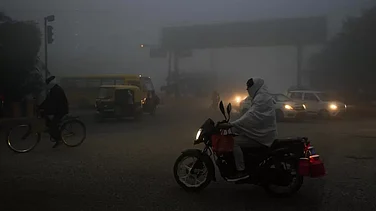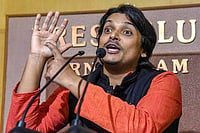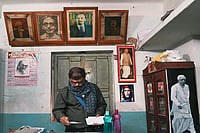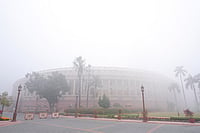THE Sangh parivar is in combat mode. Far from being cornered, the most visible strong arm of the Sangh, the Bajrang Dal, has decided to go the whole hog against Christian missionaries. At a two-day conclave in Delhi last week, the organisation decided to reach out to each and every gram pradhan and each and every household, to expose the designs of the missionaries to plant churches in every Indian village by 2001.
The Sangh clearly wants to kill two birds with one stone: take on Christians, and target Sonia as well. A task made easier, they claim, after Sonia Gandhi insulted the Hindu dharma by not signing the register at Tirupati to declare her non-Hindu origins.
The rss, in fact, started pushing its hardline Hindutva agenda right after the state assembly election debacle. And pressed the Bajrang Dal into service. For the self-styled saviours of Hindus in the Bajrang Dal, the integral humanism propounded by Deen Dayal Upadhyay does not appear to mean anything; nor do they believe in the sober talks of rashtra jeevan often put out by rss pracharaks. This bratpack is on the offensive.
We are ready to take up AK-47s if the need arises. Muslims want to turn this country into an Islamic state but we shall not let it happen, declares Ashok Kapoor, north Delhi convenor of the Bajrang Dal and son of a refugee from Jhang, Pakistan. I don't believe in demonstrations; I believe that without a danda nobody listens to you, he explains. Prakash Sharma, co-convenor of the Bajrang Dal, is equally belligerent: We have decided to write letters to all the gram pradhans about this danger and will tell the people that they (the Christians) are doing politics over the dead bodies of their children.
For a while, top vhp and Bajrang Dal leaders were hard put to distance themselves from the Staines murder. Not any longer. By their own admission, the Bajrang Dal has become synonymous with terror for the opponents of Hindus. The knife-shaped trident-wielding young men, indoctrinated by an overdose of anti-minorityism, wearing saffron bandannas, throng either a park or an abandoned field in their mohallas every morning and evening to practice martial arts.
These are the Balopasana kendras or the centres of Worship of Power. Over 2,000 such kendras have sprung up across the country in the last one year where the young men are told how Hindus are being persecuted in their own land and how Muslims and Christians are pushing an anti-national agenda. And that the onus of saving the nation is on them.
It is not all empty rhetoric. The organisation has shown time and again that when it comes to brasstacks it is always in the forefront. The organisation takes pride in incidents where they have forced their way or subjugated opponents. According to a publication of the vhp, the Bajrang Dal forcefully resisted the riots on February 14, 1986, when Muslims protested against the opening of the locked Ram temple at Ayodhya. Similarly, says the publication, on October 14, 1988, the Delhi unit of the Bajrang Dal announced that it would recite the Hanuman Chalisa at the Jama Masjid in Delhi. Following which all state units announced the programme of organising kirtans and Hanuman Chalisa recitations in masjids in their respective areas.
After every such action, a pat or two from the rss top brass is more than enough to keep a Bajrang Dal activist going. Although the Dal is part of the Sangh, the rss says it cannot be held responsible for actions of other Sangh members. This time-tested tactic was chalked out initially when the rss was banned for the first time in 1948, after the assassination of Mahatma Gandhi.
The rss functions through its several organisations so that it could not be squarely blamed for anything, says an rss-watcher. It is not necessary for the cadre to take permission from the top leadership. Activists, especially in remote tribal areas, launch militant anti-minority actions on their own like loose cannons. And if the situation goes out of control, it is easier for the rss to distance itself. This holds true not only for the Bajrang Dal but other Sangh affiliates like the Vanvasi Kalyan Ashram.
IN August 1998, an activist of the Vanvasi Kalyan Ashram in Ranchi told Outlook about a plan to demolish a church in a remote area of South Bihar. He had noted down the name of the church, area and the date on which the action was to be carried out. He said: Our leaders have no knowledge of my plans; we will tell them once we accomplish the task. The particular church was razed to the ground on the day they had decided on, August 31, 1998. Says Kapoor: There is a famous saying in the rss that the rss does not do anything and there is nothing which the rss cadre does not do. That just about sums up the modus operandi of Sangh affiliates.
The first thing the vhp and Bajrang Dal did after the Orissa incident was disown the accused Dara Singh, while condemning the incident. They also questioned the conduct of the missionary and dismissed the incident as a local reaction. Asked whether the rss would appeal to the Hindus to observe restraint as Mahatma Gandhi did after Chauri Chaura, a top rss leader retorted: No way. Why should we appeal to Hindus to observe restraint? Gandhi did what he thought was right, we are doing what we think is right.
The formation of the Bajrang Dal coincides with the anti-Sikh wave that swept the country in 1983-84 after Operation Bluestar. Then prime minister Indira Gandhi had emerged as a strong Hindu leader and to neutralise the Hindu support for her the rss planned to launch an all-out attack on the government on the issue of Ram Janmabhoomi. Riding the anti-Sikh sentiments, the Bajrang Dal organised several trishul dhaaran functions throughout the country. The activists were given a knife-like trident to be slung across the shoulder an answer to the kirpan. The Bajrang Dal has come of age during these 14 years. It has faced a ban and successfully managed to mushroom into an all-India organisation. Born to counter Sikh militancy, it has since identified new targets.


























